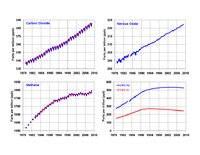Greenhouse gas monitoring

Greenhouse gas monitoring is the act of keeping a close eye on gases that trap heat in our atmosphere. These gases, like carbon dioxide and methane, are very important because they help regulate our planet's temperature and prevent it from becoming too hot or too cold.
When we burn fossil fuels like coal, oil, and gas, we emit a lot of greenhouse gases into the air. This can cause the Earth's temperature to rise, which can have harmful effects on our environment, such as melting glaciers, rising sea levels, and extreme weather conditions.
Scientists use special instruments to measure the levels of greenhouse gases in different parts of our atmosphere. They also track how the levels of these gases change over time. By monitoring greenhouse gases, we can identify areas where emissions are high and take steps to reduce them.
The information collected through greenhouse gas monitoring is used to create policies and regulations to address climate change. This includes setting targets for reducing emissions, promoting renewable energy sources, and encouraging more sustainable practices in industry, agriculture, and transportation.
Overall, greenhouse gas monitoring is a very important tool in helping us understand and mitigate the effects of climate change. By monitoring and taking action on emissions, we can help protect our planet and ensure that future generations can enjoy all the benefits of a healthy and stable environment.
When we burn fossil fuels like coal, oil, and gas, we emit a lot of greenhouse gases into the air. This can cause the Earth's temperature to rise, which can have harmful effects on our environment, such as melting glaciers, rising sea levels, and extreme weather conditions.
Scientists use special instruments to measure the levels of greenhouse gases in different parts of our atmosphere. They also track how the levels of these gases change over time. By monitoring greenhouse gases, we can identify areas where emissions are high and take steps to reduce them.
The information collected through greenhouse gas monitoring is used to create policies and regulations to address climate change. This includes setting targets for reducing emissions, promoting renewable energy sources, and encouraging more sustainable practices in industry, agriculture, and transportation.
Overall, greenhouse gas monitoring is a very important tool in helping us understand and mitigate the effects of climate change. By monitoring and taking action on emissions, we can help protect our planet and ensure that future generations can enjoy all the benefits of a healthy and stable environment.
Related topics others have asked about:
